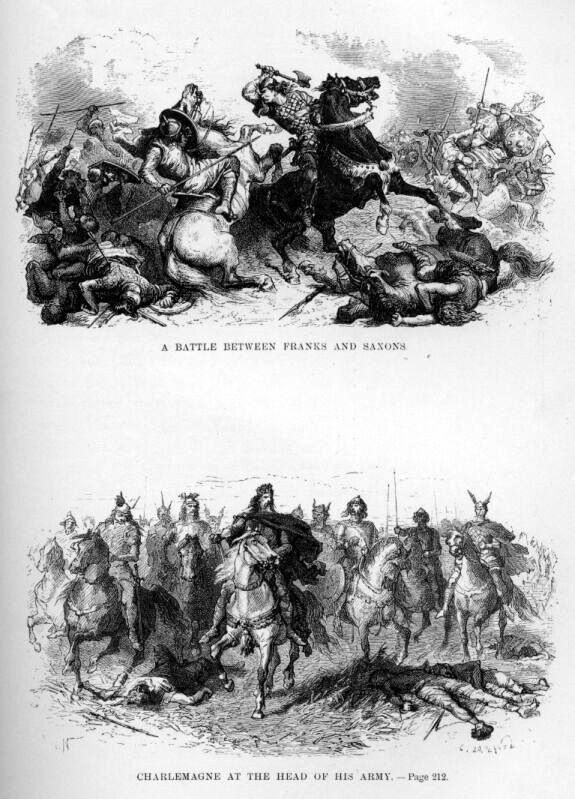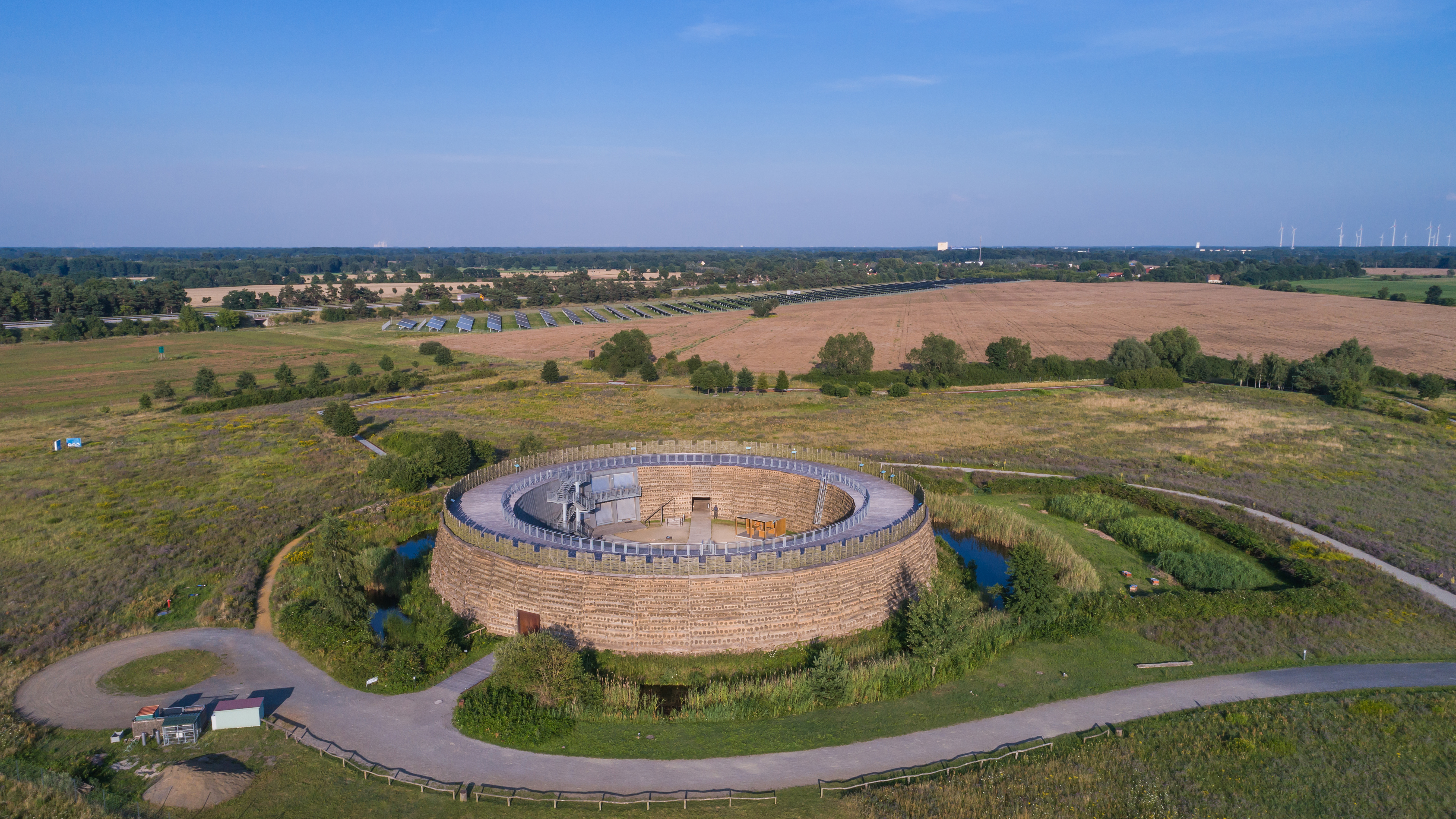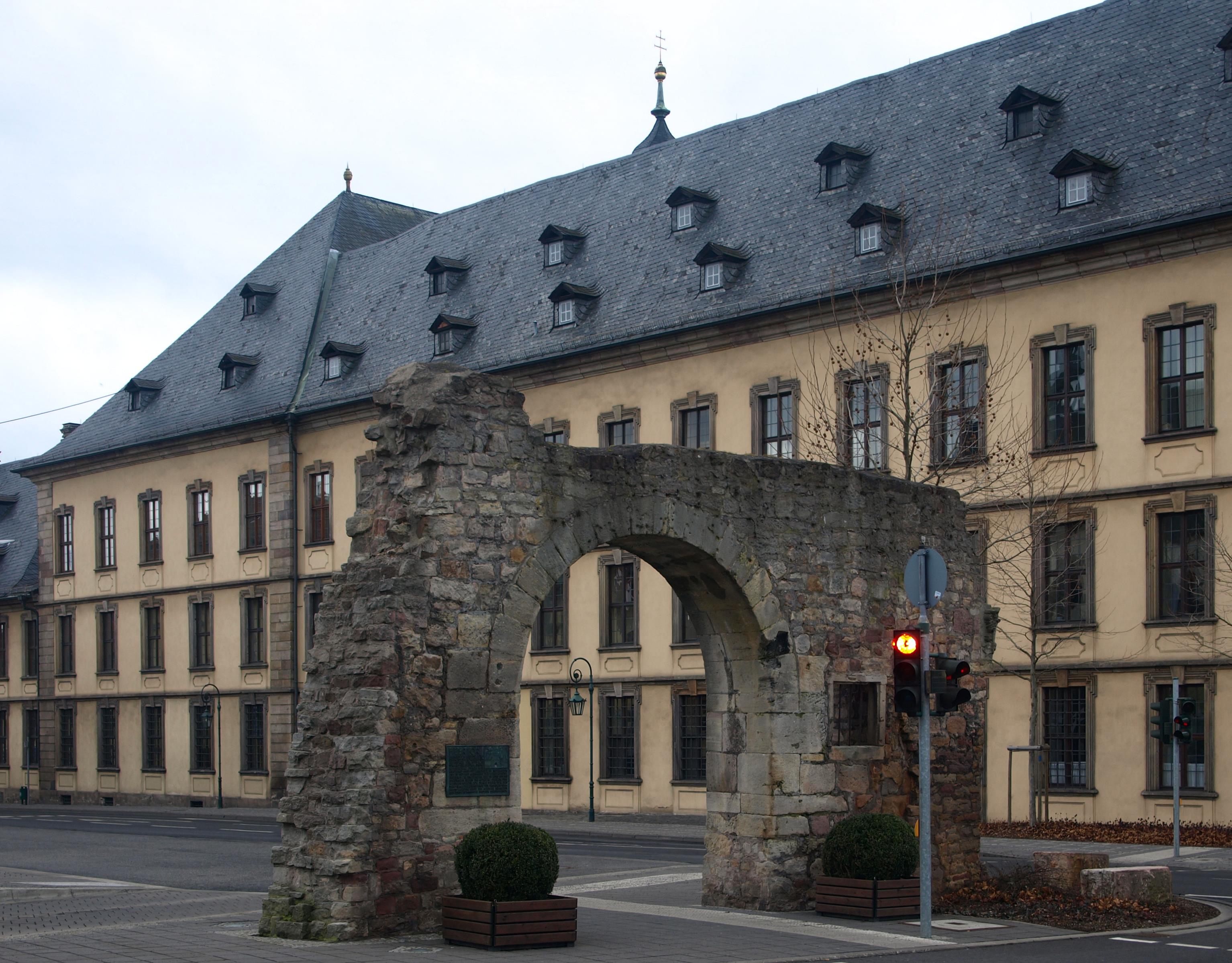|
Eresburg
The Eresburg is the largest, well-known (Old) Saxon refuge castle (''Volksburg'') and was located in the area of the present German village of Obermarsberg in the borough of Marsberg in the county of Hochsauerlandkreis. It was a hill castle built on the plateau of a low table hill, known as the ''Eresberg'', at a height of 130–150 metres above the Diemel, a tributary of the Weser, in the extreme south of the Saxon Gau of Engern on the border with the Duchy of Franconia. History There is evidence that indicates the hill was settled even in prehistoric times. Pieces of pottery from the Michelsberg culture have also been found here. Excavations in the vicinity of the present-day collegiate church have revealed traces of ditches, ramparts and posts. Radio carbon dating points to their origin in the pre-Roman Iron Age. In addition the wooden posts were made from trees that can be dated to between 420 and 370 B.C. Earlier research viewed the Eresburg as a border ... [...More Info...] [...Related Items...] OR: [Wikipedia] [Google] [Baidu] |
Obermarsberg
Obermarsberg is one of seventeen Quarter (country subdivision), quarters in the municipality of Marsberg, North Rhine-Westphalia, Germany. It is situated on the site of an Old Saxon hillfort and refuge castle, the Eresburg, on a hill 130m above the Diemel river, a tributary of the River Weser. History The location was originally the site of an Iron Age hillfort, founded probably sometime before or during the era of the Roman-Germanic wars; including the Battle of the Teutoburg Forest (circa AD 9) and the Battle of the Weser River (circa AD 16). Although it is unclear whether the surrounding area was controlled by the Cherusci, Chatti, or perhaps Marsi (Germanic), Marsi (as described by Tacitus), no particular reference to the Eresburg is known prior to the Saxon Wars (AD 770–785). During the Saxon Wars, the stronghold was repeatedly occupied by Widukind, leader of the recalcitrant Saxons (those refusing to adopt Christianity and the overlordship of the Franks), and then aban ... [...More Info...] [...Related Items...] OR: [Wikipedia] [Google] [Baidu] |
Obermarsberg Abbey
Obermarsberg is one of seventeen quarters in the municipality of Marsberg, North Rhine-Westphalia, Germany. It is situated on the site of an Old Saxon hillfort and refuge castle, the Eresburg, on a hill 130m above the Diemel river, a tributary of the River Weser. History The location was originally the site of an Iron Age hillfort, founded probably sometime before or during the era of the Roman-Germanic wars; including the Battle of the Teutoburg Forest (circa AD 9) and the Battle of the Weser River (circa AD 16). Although it is unclear whether the surrounding area was controlled by the Cherusci, Chatti, or perhaps Marsi (as described by Tacitus), no particular reference to the Eresburg is known prior to the Saxon Wars (AD 770–785). During the Saxon Wars, the stronghold was repeatedly occupied by Widukind, leader of the recalcitrant Saxons (those refusing to adopt Christianity and the overlordship of the Franks), and then abandoned to Charlemagne's forces as the Saxons ret ... [...More Info...] [...Related Items...] OR: [Wikipedia] [Google] [Baidu] |
Saxon Wars
The Saxon Wars were the campaigns and insurrections of the thirty-three years from 772, when Charlemagne first entered Saxony with the intent to conquer, to 804, when the last rebellion of tribesmen was defeated. In all, 18 campaigns were fought, primarily in what is now northern Germany. They resulted in the incorporation of Saxony into the Frankish realm and their forcible conversion from Germanic paganism to Christianity. The Saxons were divided into four subgroups in four regions. Nearest to the ancient Frankish kingdom of Austrasia was Westphalia, and farthest was Eastphalia. In between the two kingdoms was that of Engria (or Engern), and north of the three, at the base of the Jutland peninsula, was Nordalbingia. Despite repeated setbacks, the Saxons resisted steadfastly, returning to raid Charlemagne's domains as soon as he turned his attention elsewhere. Their main leader, Widukind, was a resilient and resourceful opponent, but eventually was defeated and bapti ... [...More Info...] [...Related Items...] OR: [Wikipedia] [Google] [Baidu] |
Irminsul
An Irminsul (Old Saxon 'great pillar') was a sacred, Column, pillar-like object attested as playing an important role in the Germanic paganism of the Saxons. Medieval sources describe how an Irminsul was destroyed by Charlemagne during the Saxon Wars. A church was erected on its place in 783 and blessed by Pope Leo III. Sacred trees and groves in Germanic paganism and mythology, Sacred trees and sacred groves were widely venerated by the Germanic peoples (including Donar's Oak), and the oldest chronicle describing an Irminsul refers to it as a tree trunk erected in the open air.d'Alviella (1891:112). Etymology The Old Saxon word compound means 'great pillar'. The first element, ('great') is cognate with terms with some significance elsewhere in Germanic mythology. Among the North Germanic peoples, the Old Norse form of is , which just like is one of the List of names of Odin, names of Odin. Yggdrasil (Old Norse 'Yggr's horse') is a Norse cosmology, cosmic tree from which Odin ... [...More Info...] [...Related Items...] OR: [Wikipedia] [Google] [Baidu] |
Saxons
The Saxons, sometimes called the Old Saxons or Continental Saxons, were a Germanic people of early medieval "Old" Saxony () which became a Carolingian " stem duchy" in 804, in what is now northern Germany. Many of their neighbours were, like them, speakers of West Germanic dialects, including the inland Franks and Thuringians to the south, and the coastal Frisians and Angles to the north who were among the peoples who were originally referred to as "Saxons" in the context of early raiding and settlements in Roman Britain and Gaul. To their east were Obotrites and other Slavic-speaking peoples. The political history of these continental Saxons is unclear until the 8th century and the conflict between their semi-legendary hero Widukind and the Frankish emperor Charlemagne. They do not appear to have been politically united until the generations leading up to that conflict, and before then they were reportedly ruled by regional "satraps". Previous Frankish rulers of Austrasia ... [...More Info...] [...Related Items...] OR: [Wikipedia] [Google] [Baidu] |
Refuge Castle
A refuge castleCreighton, Oliver (2015). ''Early European Castles''. Bloomsbury. or refuge fort (, also ''Fluchtburg'', ''Volksburg'', ''Bauernburg'' or ''Vryburg'') is a castle-like defensive location, usually surrounded by Rampart (fortification), ramparts, that is not permanently occupied but acts as a temporary retreat for the local population when threatened by war or attack. In former times such sites were also described as giant castles (German: ''Hünenburgen'') because their origin was ascribed to Giant (mythology), giants. History In Europe a multitude of large protohistoric sites surrounded by earthworks has been uncovered by archaeological excavations, many over 100 metres in diameter, that are understood to be refuge castles. Amongst ancient historical references to them are the refuge castles of the Gauls described by Julius Caesar, Caesar as ''oppida'', although they could also be permanent settlements. Similar ringwork (''Ringwall'') systems were built by th ... [...More Info...] [...Related Items...] OR: [Wikipedia] [Google] [Baidu] |
Charlemagne
Charlemagne ( ; 2 April 748 – 28 January 814) was List of Frankish kings, King of the Franks from 768, List of kings of the Lombards, King of the Lombards from 774, and Holy Roman Emperor, Emperor of what is now known as the Carolingian Empire from 800, holding these titles until his death in 814. He united most of Western Europe, Western and Central Europe, and was the first recognised emperor to rule from the west after the fall of the Western Roman Empire approximately three centuries earlier. Charlemagne's reign was marked by political and social changes that had lasting influence on Europe throughout the Middle Ages. A member of the Frankish Carolingian dynasty, Charlemagne was the eldest son of Pepin the Short and Bertrada of Laon. With his brother, Carloman I, he became king of the Franks in 768 following Pepin's death and became the sole ruler three years later. Charlemagne continued his father's policy of protecting the papacy and became its chief defender, remo ... [...More Info...] [...Related Items...] OR: [Wikipedia] [Google] [Baidu] |
Hill Castle
A hill castle or mountain castle is a castle built on a natural feature that stands above the surrounding terrain. It is a term derived from the German ''Höhenburg'' used in categorising castle sites by their topographical location. Hill castles are thus distinguished from lowland castles (''Niederungsburgen''). Hill castles may be further subdivided depending on their situation into the following: * Hilltop castle (''Gipfelburg''), that stands on the summit of a hill with steep drops on all sides. A special type is the rock castle or ''Felsenburg''. * Ridge castle (''Kammburg''), that is built on the crest of a ridge. * Hillside castle (''Hangburg''), that is built on the side of a hill and thus is dominated by rising ground on one side. * Spur castle (''Spornburg''), that is built on a hill spur surrounded by steep terrain on three sides and thus only needs to be defended on the one remaining side. When in the 10th and 11th centuries castles lost their pure fortress character a ... [...More Info...] [...Related Items...] OR: [Wikipedia] [Google] [Baidu] |
List Of Frankish Kings
The Franks, Germanic peoples that invaded the Western Roman Empire in the 5th century, were first led by individuals called dux, dukes and monarch, reguli. The earliest group of Franks that rose to prominence was the Salian Franks, Salian Merovingian dynasty, Merovingians, who conquered most of Roman Gaul, as well as the Gaulish territory of the Visigothic Kingdom, following the Battle of Vouillé in 507 AD. The sons of Clovis I, the first King of the Franks, conquered the Kingdom of the Burgundians, Burgundian and the Alamannia, Alamanni Kingdoms. They acquired Provence, and went on to make the peoples of the Bavarii and Thuringii their clients. The Merovingians were later replaced by the new Carolingian dynasty in the 8th century. By the late 10th century, the Carolingians themselves had been replaced throughout much of their realm by other dynasties. A timeline of Frankish rulers has been difficult to trace since the realm, according to old Germanic practice, was frequently ... [...More Info...] [...Related Items...] OR: [Wikipedia] [Google] [Baidu] |
Fulda
Fulda () (historically in English called Fuld) is a city in Hesse, Germany; it is located on the river Fulda and is the administrative seat of the Fulda district (''Kreis''). In 1990, the city hosted the 30th Hessentag state festival. History Middle Ages In 744 Saint Sturm, a disciple of Saint Boniface, founded the Benedictine monastery of Fulda as one of Boniface's outposts in the reorganization of the church in Germany. The initial grant for the abbey was signed by Carloman, Mayor of the Palace in Austrasia (in office 741–47), the son of Charles Martel. The support of the Mayors of the Palace, and later of the early Pippinid and Carolingian rulers, was important to Boniface's success. Fulda also received support from many of the leading families of the Carolingian world. Sturm, whose tenure as abbot lasted from 747 until 779, was most likely related to the Agilolfing dukes of Bavaria. Fulda also received large and constant donations from the Etichonids, a lea ... [...More Info...] [...Related Items...] OR: [Wikipedia] [Google] [Baidu] |
Segestes
Segestes was a nobleman of the Germanic tribe of the Cherusci involved in the events surrounding the Roman attempts to conquer northern Germany during the reign of Augustus and then Tiberius. Arminius, the Cheruscan noble and military leader, had married Thusnelda, Segestes' daughter, against her father's will. As a result, Segestes, who favoured Roman overlordship, bore an ongoing grudge against Arminius. In AD 9 he warned the Roman governor Publius Quinctilius Varus of the impending uprising of his countrymen, but he was not believed. Varus and his three legions subsequently perished in the three-day Battle of the Teutoburg Forest, where several allied German tribes under the command of Arminius ambushed them. Segestes openly turned against Arminius when Germanicus invaded northern Germany in AD 15 in a renewed attempt to establish Roman rule in the area. Besieged in his stronghold by his own countrymen, Segestes appealed for help to Germanicus whose forces relieved the sieg ... [...More Info...] [...Related Items...] OR: [Wikipedia] [Google] [Baidu] |





